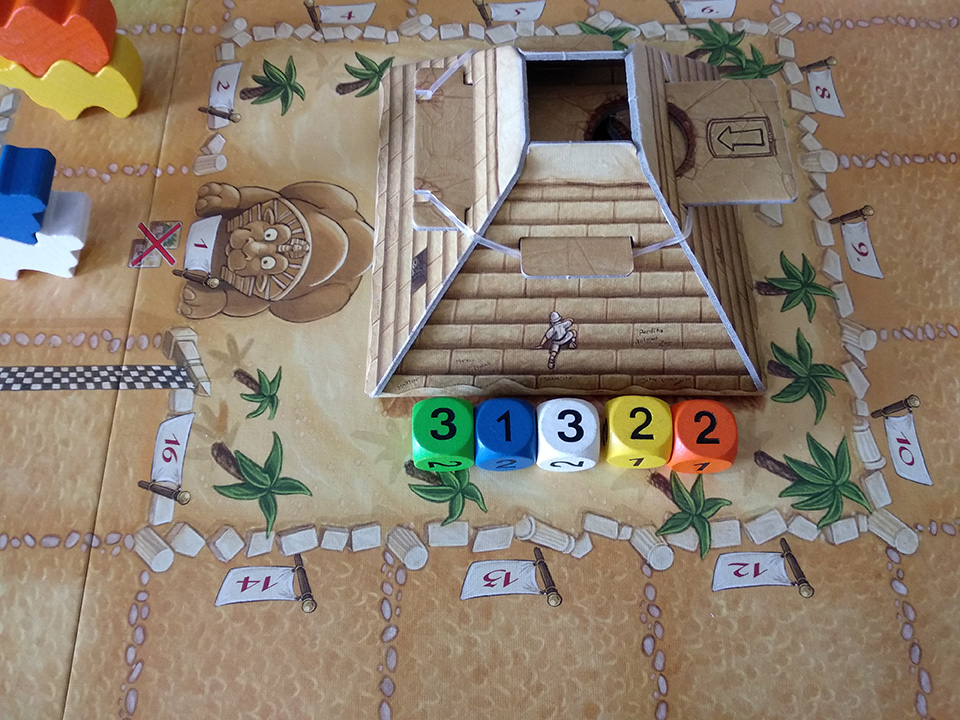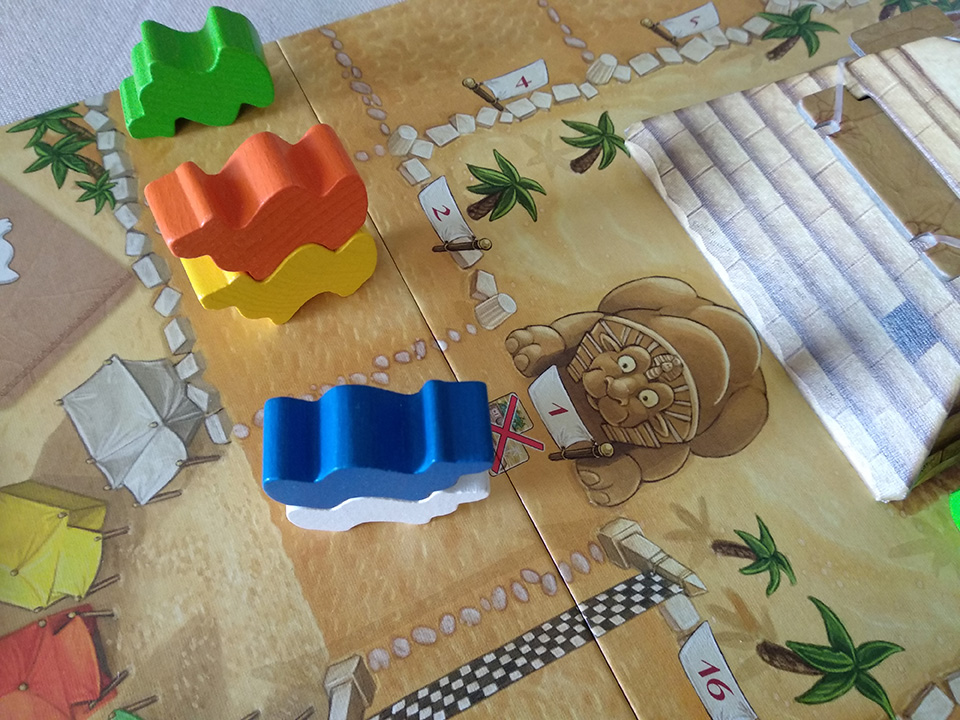Camel Up - Board Games You Can Play Blind
We have all gathered to watch and make some easy cash at an exciting and unpredictable camel race around a pyramid in Egypt. Place your bets and start biting your nails as you root for your favorite camel rushing to the finish line!
Introduction
In this installment of the “Board Games You Can Play Blind” series, we take a look at a game that belongs to the betting genre. So far, we’ve covered a cooperative game, Pandemic, and a team based social deduction game, Secret Hitler, and now it is time to talk about a competitive game where you only care about yourself!
As usual, we will start with the game overview and how it is played followed by the visual accessibility analysis and what challenges blind players need to overcome to be able to play this game.
 Image showing all the game components
Image showing all the game components
Game Overview
-
Game name: Camel Up
-
Publisher: eggertspiele
-
Player count: 2-8
-
Playing time: 20-30 minutes
Camel Up is a betting game where players compete with each other to accumulate the highest amount of Egyptian Pounds before the camel race is over. The game ends as soon as one of the camels crosses the finish line, and the player with the highest amount of money wins. There are multiple ways for the players to increase their funds: betting on the current leg (round), betting on the race winner or loser, using the dice pyramid to move a camel, and finally putting a tile on the race track that gives the player one Egyptian Pound every time a camel lands on it.
The four different ways of making money that I mentioned above also represents the four different actions that a player can take on their turn. Let’s briefly cover what each action does:
-
Place a bet on leg winner - The player can place a bet on a camel that they believe will be in the first position at the end of the leg. A leg (or ‘round’ as I like to call it) ends when all five camels have moved. Each camel can move only once per leg.
-
Place a bet on race winner or loser - The player can bet on the race winner or loser (camel in last place). This is a hidden bet, and other players should not know this information. These bets are revealed at the end of the race and the players that guessed the winner or loser first, get the highest amount of money (8 Egyptian Pounds). Other players with correct bets get less amount of money.
-
Move a camel by using the dice pyramid - The player can use the dice pyramid to roll a six sided die. Each camel has its own die with the same color. Each die is numbered from 1 to 3, so camels can move at most 3 spots on the track. The die that pops out of the pyramid makes the corresponding camel move on the track. This action awards 1 Egyptian Pound to the player.
-
Place a desert tile on the race track - A player can place their desert tile on the race track which gives them 1 Egyptian Pound every time a camel lands on it. The tile has two sides: mirage, which makes the camel move one spot backwards, and oasis, which makes the camel move one spot forward.
So far, the game sounds quite simple but there is a small twist that makes it much more fun. These camels can go on top of each other when they land on the same position on the race track as well as carry each other along the track. This stacking mechanic makes the game slightly more unpredictable since the camels on top are considered to be ‘in front’ of the group.
To demonstrate the uncertainty that the stacking mechanic adds, let’s consider the following scenario; the green camel needs to move one spot to cross the finish line. To win, all the green camel needs is the green die to pop out of the pyramid when a player decides to roll. The blue camel is behind the green camel and needs to move 4 slots to win the race. Now, on the dice, the highest number is 3, so the blue camel can’t move 4 slots by rolling the die alone, but what can happen is, the blue die comes out of the pyramid first showing a 3 which puts the blue camel on top of the green camel and also in the lead. After this, regardless of what the green die shows when rolled, the green camel carries the blue camel over the finish line, making the blue camel the winner of the race.
 Image showing the dice and dice pyramid
Image showing the dice and dice pyramid
Camel Up is a great gateway game to introduce new players to board games as the rules are simple and easy to pick up. Most players would only need to play once to understand how the game works. As you play more games, you will start improving your strategy and making less bad or risky bets, but even though strategy plays an important role and can change the final outcome of a game, you cannot avoid the factor of luck. This however, is not a bad thing. The factor of luck and uncertainty is what makes Camel Up extremely fun for both adults and children. If you are looking for a game where the most skilled player always wins, you should look elsewhere.
Visual Accessibility
Alright, let’s see how difficult it is to play Camel Up as a blind player. You may feel like there are too many variables to track, but in reality, once you get a hang of the rules, it should be relatively easy to stay on top of what is going on.
If you have read any of my previous posts, you are aware that the biggest problem for blind players is hidden information. Like many other competitive games, Camel Up also has hidden information, but it is very minimal and can be worked around without a sweat.
The only action that has hidden information is placing a bet on race winner or loser. The player has to choose one card that shows the color of the camel they want to bet on and put it face down on the winner or loser pile. The good news here is, there are only five cards for the five different colors, so the blind player can simply ask a sighted player to arrange the cards in the order they want. Memorizing the order shouldn’t be too difficult since the number of cards is quite low, and once you play a card (place a bet) you can’t get it back, so there is no danger of mixing the cards up.
 Image showing the 5 cards used for race winner or loser bets
Image showing the 5 cards used for race winner or loser bets
After overcoming this problem, the rest of the information in the game is public and the blind player can simply ask about the state of the game. If a blind player is present, the sighted players should announce the action they are taking just to make it easier for the blind player to follow the game. If the blind player happens to be shy, they may not want to repeatedly ask the players about what action they took.
 Image showing camels on the race track
Image showing camels on the race track
The numbers on the race track are very helpful for blind players to visualize where the camels are located along the track and how far they are from the finish line. The camel positions can change often during the race and if the blind player loses track of the current positioning, it only takes sighted players a couple of seconds to update the blind player on the current game state. It is also very easy to keep track of how much money one currently has since the money tokens can be distinguished by touch as different values have different sizes.
 Image showing money tokens for 1, 5, 10, and 20 Egyptian Pounds
Image showing money tokens for 1, 5, 10, and 20 Egyptian Pounds
Finally, I should mention that even though blind players can play Camel Up without many difficulties, at least one sighted player must be present around the table. Sighted players are the ones that can physically move the camels on the track and also announce the result of a rolled die. You also need a sighted player to go through the winner and loser bets at the end of the race because the only way to find out who the bet belongs to is looking at an image on the cards that shows the character that the player has chosen at the beginning of the game.
Conclusion
Camel Up has been a hit with a couple of groups I have played the game with and is a game I would highly recommend to blind players. If you have a blind friend that has never played board games, this is a great game to introduce them to the hobby as it is very simple yet super entertaining. The game is also on the cheap end, costing about 25 Euros in Europe.
As always, if you have any questions or suggestions, feel free to leave a comment below. If you are a blind or visually impaired player, or have a blind player in your gaming grouop, I’d love to hear about the games you enjoy playing.
Resources
- Video: How To Play Camel Up - Link
Leave a comment